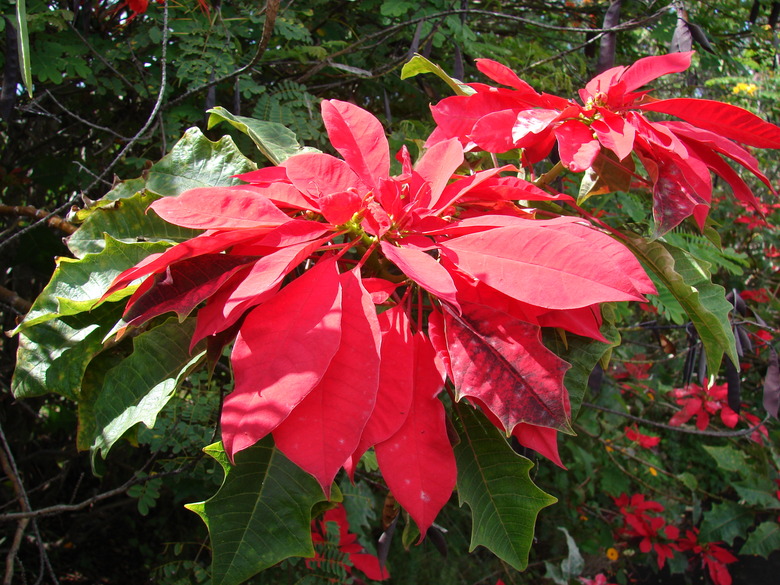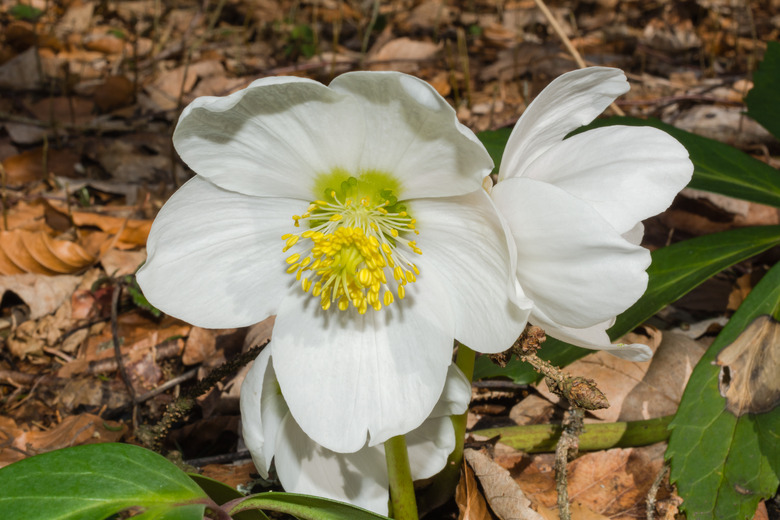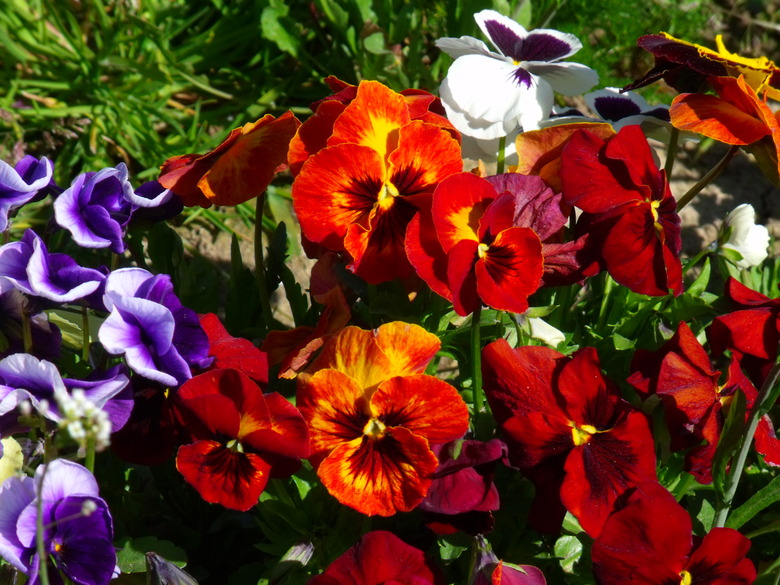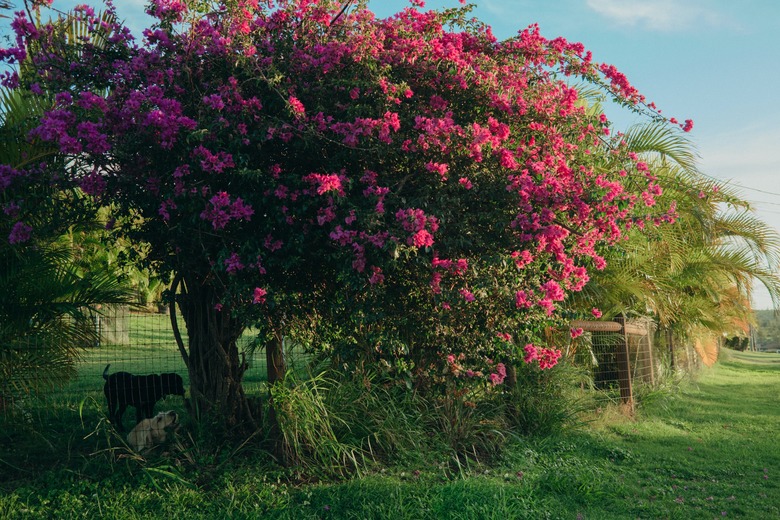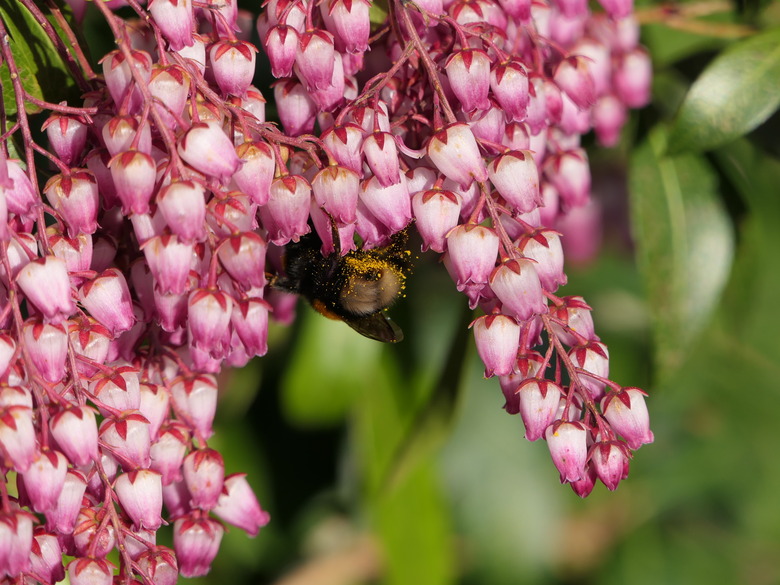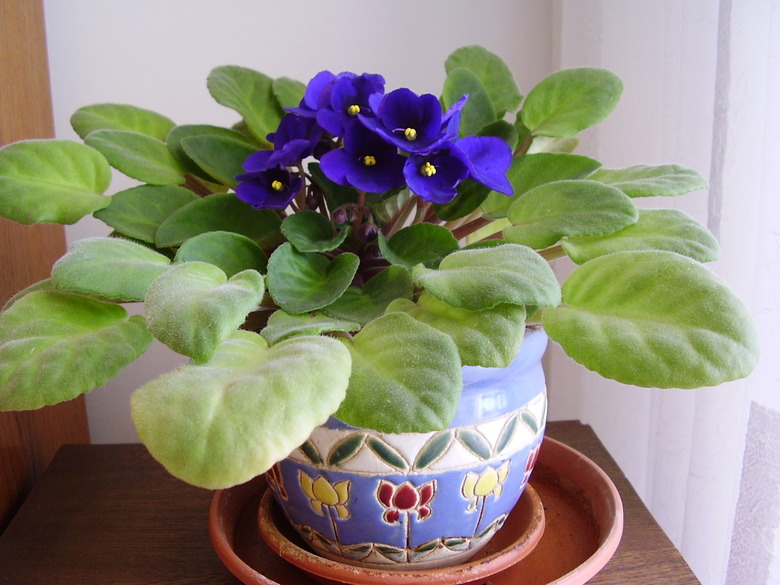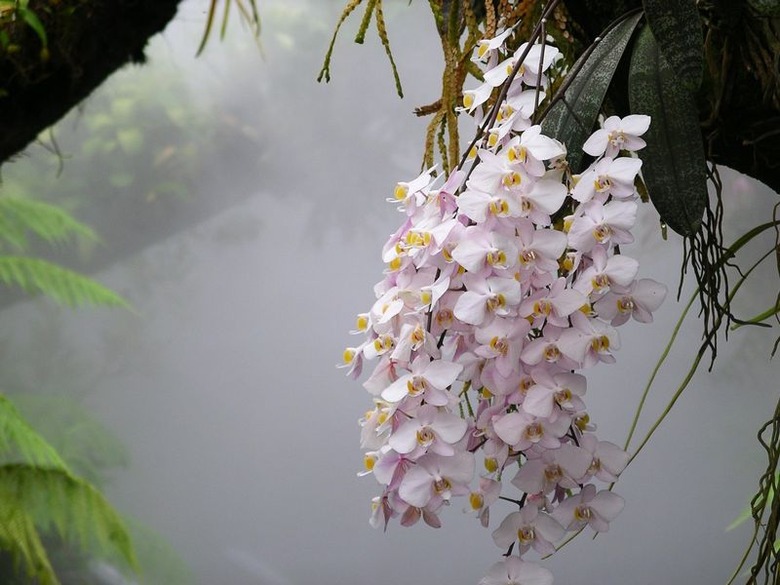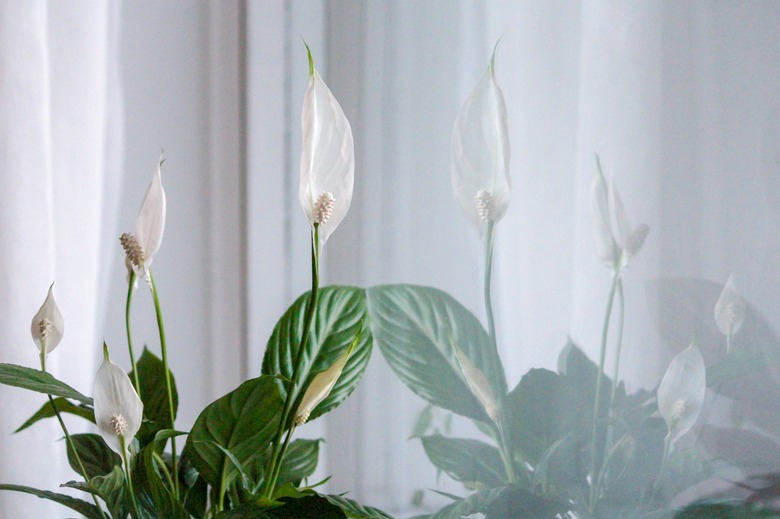What Flowers Are In Bloom In December?
The dreary days of winter feature bare branches, dead grass and fog, rain or snow. Despite the gray skies and brown foliage that fill the garden, however, there are many flowers that bloom in December.
From bedding and border plants to bulbs to shrubs and trees, depending on the local climate, a bright winter garden thrives outdoors or near a brightly lit window indoors.
Planting Flowers in the Garden
Before planting in the garden, consider the environmental factors that determine the success of a winter flower garden, such as soil type, soil fertility, sun exposure and shelter from winter winds. All of these conditions are essential to healthy plants that flower in December or all winter long.
In addition, while the plants may usually bloom in December, they may flower earlier or later depending on the U.S. Department of Agriculture plant hardiness zones and the year's winter weather. The mild climate of USDA zone 9 may see continuous blossoms through the winter, while plant growth and flowering may be delayed in the icy cold winters of USDA zone 3.
Christmas Rose
The Christmas rose (Helleborus niger), also known as black hellebore, blooms around Christmas in warmer climates, but the flowers may appear in February or later in the coldest zones. Native to southern and central Europe, the clumping plants may be used as a ground cover or border plant.
- **Type:** Evergreen perennial
- **Size:** 8 to 15 inches tall and 12 to 18 inches wide
- **Color:** White to pale pink
- **Light:** Part to full shade
- **USDA Zones:** 3 to 8
Primrose
Primroses (Primula spp.) are cool-season perennials that can be grown indoors as long as the temperature stays below 80°F during the day and between 50 and 60°F at night. Outdoors, use it as a ground cover or border plant. The plants may go dormant during hot summer weather and then perk up when temperatures cool in fall.
- **Type:** Perennial, annual
- **Size:** 6 to 20 inches tall and wide
- **Color:** White, pink, red, yellow, orange, blue, purple
- **Light:** Part to full shade
- **USDA Zones:** 3 to 8
Glory of the Snow
Glory of the snow (Chionodoxa forbesii), native to Turkey, should be planted 3 inches deep in late summer and early fall. Unlike most plants, glory of the snow thrives even when planted under and around black walnut trees. It is also deer tolerant. Plant it in rock gardens and under shade trees to naturalize for winter to spring color.
- **Type:** Bulb
- **Size:** 6 to 10 inches tall
- **Color:** Blue and white
- **Light:** Full sun to part shade
- **USDA Zones:** 3 to 8
Pansies
Pansies (Viola x wittrockiana) bloom most of the winter in warm climates but die back when hot summer temperatures arrive. While a perennial, pansies are often treated as annuals and replaced for fall color.
- **Type:** Perennial, grown as annual
- **Size:** 6 to 8 inches tall, 8 to 12 inches wide
- **Color:** White, yellow, orange, rose, red, blue, purple, bicolor, tricolor
- **Light:** Full sun to part shade
- **USDA Zones:** 6 to 10, depending on the species and cultivar
Snowdrops
Snowdrops (Galanthus nivalis), also known as galanthus, may bloom even when snow is on the ground. Plant the bulbs in late summer or early fall along paths and in rock gardens.
- **Type:** Bulb
- **Size:** 6 to 8 inches tall, 4 to 6 inches wide
- **Color:** White
- **Light:** Full sun to part shade
- **USDA Zones:** 3 to 7
Winter-Flowering Clematis
Winter-flowering clematis (Clematis cirrhosa) clambers up a trellis or sprawls over the soil. Native to the Mediterranean, it prefers a sheltered south- or west-facing wall where its vines can climb up to catch the winter sun. The flowers appear in December and continue into early spring.
- **Type:** Evergreen or semievergreen vine
- **Size:** 4 to 20 feet tall, 1 to 4 feet wide
- **Color:** White, cream, yellow, gold
- **Light:** Full sun to part shade
- **USDA Zones:** 7b to 9a
Winter-Flowering Shrubs and Trees
Winter-flowering shrubs and trees vary in their bloom times depending on the climate and current winter conditions.
Proper pruning is essential for most flowering shrubs. While many gardeners get out their shears in late summer and fall, winter-flowering shrubs should be pruned as soon as the flowers fade.
Most produce new flower buds through spring and summer; prune too late and the next season's winter flower show will be affected.
Bougainvillea
Bougainvillea (Bougainvillea spp.) is a tough woody vine that brings the tropics into the garden. The colorful bracts are actually modified leaves that hide the small yellow and white flowers. Bougainvilleas bloom year round in warm climates, but plant them in pots and take the plants indoors when winter temperatures drop below freezing.
- **Type:** Evergreen woody scrambler
- **Size:** 15 to 40 feet tall and wide
- **Color:** White, yellow, pink, red, purple
- **Light:** Full sun
- **USDA Zones:** 9b to 10a
Warning
Bougainvilleas have extremely sharp 1-inch-long green thorns hidden in the foliage. Use caution when pruning or working around the vines or plant thornless cultivars, like Miss Alice.
Fragrant Sweetbox
Fragrant sweetbox (Sarcococca ruscifolia) has small flowers, and the scent of vanilla fills the air near this shrub. Plant it where the fragrance can be enjoyed. While sweetbox tolerates dry soils, it prefers regular watering and mulch to keep the soil evenly moist.
- **Type:** Evergreen shrub
- **Size:** 3 to 6 feet tall and wide
- **Color:** White
- **Light:** Part to full shade
- **USDA Zones:** 7b to 9
Mahonia
Mahonia (Mahonia x 'Charity') features large, frond-like evergreen leaves and winter flowers followed by black ornamental berries. While this shrub can be grown in containers, it is best used in borders or hedges.
- **Type:** Evergreen shrub
- **Size:** 10 to 15 feet tall and wide
- **Color:** Yellow
- **Light:** Part to full shade
- **USDA zones:** 7 to 9
Japanese Pieris
Japanese pieris (Pieris japonica) produces showy floral buds in late summer that open into dropping clusters of 1/4-inch flowers. This slow-growing shrub is deer resistant but should be planted out of the reach of children and pets.
- **Type:** Evergreen shrub to small tree
- **Size:** 8 to 10 feet tall, 6 to 8 feet wide
- **Color:** White
- **Light:** Full to part sun
- **USDA Zones:** 4b to 8b
Warning
The leaves, sap, flowers and nectar of pieris are highly toxic to humans, pets and horses. Ingesting any part of the plant may result in gastric distress, convulsions and death.
Razzleberri® Fringe Flower
Razzleberri® fringe flower (Loropetalum chinense 'Monraz') features fragrant, bright raspberry-fringed flowers year round. New leaves appear in burgundy and mature to olive green. Use it as a focal point or backdrop in the flower or Zen garden.
- **Type:** Evergreen shrub
- **Size:** 4 to 6 feet tall, 4 to 5 feet wide
- **Color:** Raspberry red
- **Light:** Full to part sun
- **USDA Zones:** 7 to 9
Winter Daphne
Winter daphne (Daphne odora 'Marginata') produces winter-to-spring red buds that open to fragrant, pink-edged white flowers amid the yellow-edged green leaves. Trim only to shape the shrub; avoid severe pruning.
- **Type:** Evergreen shrub
- **Size:** 3 to 6 feet tall and wide
- **Color:** White edged with pink
- **Light:** Full sun to part shade
- **USDA Zones:** 7 to 9
Winter Heath
Winter heath (Erica carnea 'December Red') features masses of white, pink, purple or red blossoms from December to February, with the cultivar December Red blooming earlier than the other cultivars. This hardy, low-growing shrub prefers a sunny, well-drained location in the garden.
- **Type:** Perennial shrub, ground cover
- **Size:** 6 to 12 inches tall, 18 to 24 inches wide
- **Color:** White, pink, purple, red
- **Light:** Full sun
- **USDA Zones:** 5 to 9, depending on the cultivar
Winter's Rose Camellia
Winter's Rose camellia (Camellia 'Winter's Rose') is one of the Winter Series hybrids developed by Dr. William Ackerman after a series of devastatingly cold winters in North Carolina. The pink double flowers contain 28 petals, which are shed singly, so deadheading is not necessary.
- **Type:** Evergreen shrub
- **Size:** 2 to 12 feet tall, 2 to 8 feet wide
- **Color:** White, pink, purple
- **Light:** Part shade
- **USDA Zones:** 6a to 9b
Witch Hazel
Witch hazel (Hamamelis virginiana), native to eastern North America, produces its fragrant yellow flowers between October and December, usually after dropping its leaves. Plant it as a border, screen or hedge.
- **Type:** Deciduous shrub or small tree
- **Size:** 15 to 20 feet tall and wide
- **Color:** Yellow
- **Light:** Full sun to part shade
- **USDA Zones:** 3 to 8
Growing Indoor Flowers in December
Indoor gardeners have multiple options in flowering plants to enhance their holiday season.
Some require forcing, such as the ever-popular paperwhite bulbs, and others have specific light requirements, such as Christmas cactus and poinsettias. Planting in pots and providing the correct light, water and temperatures result in a colorful display of December flowers.
In addition, potted citrus may bloom and produce fruit year round in a warm, sunny window.
African Violets
African violets (Saintpaulia ionantha) are happy little flowers that prefer the warm temperatures of the average home. Keep it out of drafts and water regularly and these small plants will bloom year round.
- **Type:** Perennial
- **Size:** 6 to 8 inches tall and wide
- **Color:** White, pink, blue, purple, bicolor
- **Light:** Bright filtered light or part to full shade
- **USDA Zones:** 11 to 12
Amaryllis
Amaryllis (Hippeastrum spp.) produces two to six flowers approximately five weeks after planting in flowerpots. Generally, plant the bulbs at Thanksgiving for Christmas blossoms. Place them in bright light and water regularly.
- **Type:** Bulb
- **Size:** 12 to 24 inches tall, 8 to 12 inches wide
- **Color:** Red, pink, white, bicolor
- **Light:** Full sun to part shade
- **USDA Zones:** 8 to 10
Anthuriums
Anthuriums (Anthurium andraeanum), also known as flamingo lily and painter's palette, bring the tropics indoors. When given bright light and watered regularly, these South American hybrids produce flowers year round.
- **Type:** Epiphytic
- **Size:** 12 to 18 inches tall and equally wide
- **Color:** Red, pink
- **Light:** Bright filtered light or part shade
- **USDA Zones:** 11 to 12
Christmas Cactus
Christmas cactus (Schlumbergera bridgesii syn Schlumbergera buckleyi) is one of the three holiday cacti native to South America. These succulents are tropical plants and require regular watering. To encourage flowering, provide 13 hours of uninterrupted darkness every night and night temperatures between 55 and 65°F beginning in September and continuing for six to eight weeks or until the flower buds form.
- **Type:** Succulent
- **Size:** 10 inches tall, 24 inches wide
- **Color:** Pink, rose, red
- **Light:** Bright filtered or indirect light, part shade
- **USDA Zones:** 10 to 12
Moth Orchids
Moth orchids (Phalaenopsis spp.) are among the easiest orchids to grow. Water the plant weekly and when it begins to flower, cut the water back to every other week. Place the pot in the sink and allow the water to slowly trickle into the pot until it drains from the bottom. Turn off the water, wait for the pot to drain and then repeat the process twice to ensure that the roots and planting medium have absorbed enough moisture.
- **Type:** Epiphyte
- **Size:** 10 to 36 inches tall, 12 inches wide
- **Color:** White, yellow, pink, rose, purple, bicolor
- **Light:** Bright filtered light
- **USDA Zones:** 10 to 12
Meyer Lemons
A Meyer lemon tree (Citrus x meyeri 'Meyer Improved') provides flowers, a sweet citrus scent and lemons for the kitchen and beverages. These naturally small lemon trees will stay small when planted in a 5- to 10-gallon container and kept in a sunny, draft-free sunroom. Add a grow light if necessary and water regularly.
- **Type:** Evergreen tree
- **Size:** 6 to 10 feet tall, 4 to 8 feet wide
- **Color:** White with yellow fruits
- **Light:** Full sun to part shade
- **USDA Zones:** 9 to 11
Paperwhites
Paperwhites (Narcissus spp.) may be forced for holiday flowers. Pack a single layer of bulbs tightly into a shallow bowl on top of a layer of pebbles. Add water to touch the base of the bulbs and the paperwhites will grow and flower. They can also be planted in potting mix and placed in a brightly lit window. Water regularly and watch the bulbs grow.
- **Type:** Bulb
- **Size:** 16 to 24 inches tall
- **Color:** White
- **Light:** Bright filtered light or full sun
- **USDA Zones:** 8 to 11
Peace Lilies
Peace lilies (Spathiphyllum spp.) flower year round when watered regularly and when kept in bright light. While they tolerate low light levels, it can affect the plant's ability to produce flowers. Water with distilled water or allow tap water to sit out overnight so the chlorine dissipates.
- **Type:** Perennial
- **Size:** 1 to 6 feet tall, 1 to 5 feet wide
- **Color:** White
- **Light:** Part to full shade
- **USDA Zones:** 11 to 12
Poinsettias
Poinsettias (Euphorbia pulcherrima) grow outside in warm, frost-free climates but are usually grown as houseplants. To produce flowers for Christmas, keep the plant in darkness for at least 12 hours daily and then put it in bright light during the day. The uninterrupted darkness stimulates the color change from green to red in the bracts that surround the small yellow flowers. After the holidays, repot and trim the plant; continue to water and fertilize to encourage new growth.
- **Type:** Deciduous shrub
- **Size:** 3 to 12 feet tall, 3 to 8 feet wide
- **Color:** Red, pink, white, bicolor
- **Light:** Part shade
- **USDA Zones:** 9 to 11
References
- Missouri Botanical Garden: Helleborus niger
- Missouri Botanical Garden: Primula (Polyanthus Type)
- Missouri Botanical Garden: Chionodoxa forbesii
- House Beautiful: 17 Winter Flowers That Will Thrive During the Coldest Months of the Year
- North Carolina Extension Gardener Plant Toolbox: Clematis cirrhosa
- Monrovia: Charity Mahonia
- Oregon State University OSU Extension Service: Six Stellar Shrubs to Brighten the Winter Garden
- North Carolina Extension Gardener Plant Toolbox: Pieris japonica
- Fine Gardening: 'Marginata' Winter Daphne
- Gardenia: Erica carnea 'December Red' (Winter Heath)
- Missouri Botanical Garden: Hamamelis virginiana
- North Carolina Extension Gardener Plant Toolbox: Camellia 'Winter's Rose'
- Missouri Botanical Garden: Saintpaulia ionantha
- Missouri Botanical Garden: Hippeastrum (Group)
- Adams Fairacre Farms: Caring for Phalaenopsis Orchids
- Missouri Botanical Garden: Spathiphyllum (Group)
- Missouri Botanical Garden: Euphorbia pulcherrima
